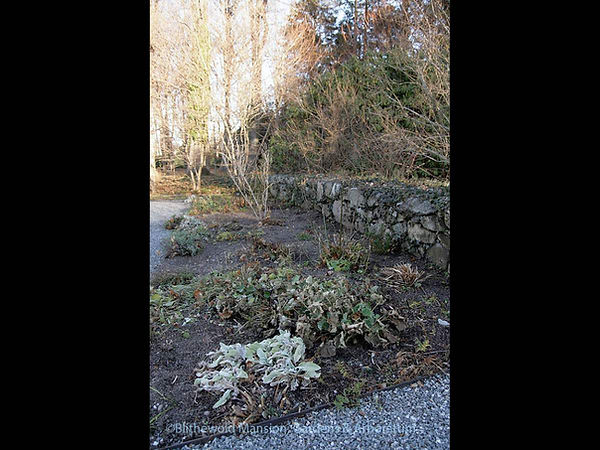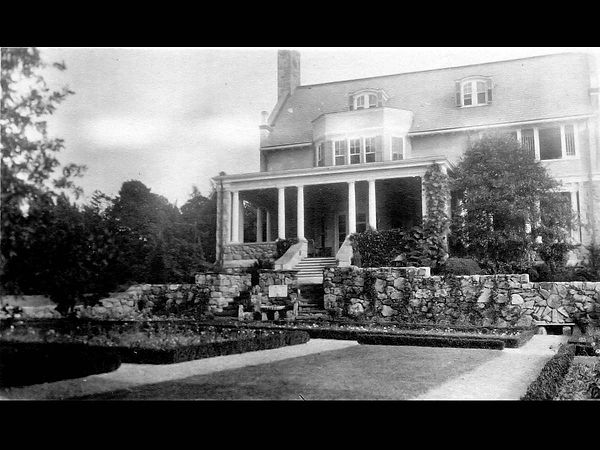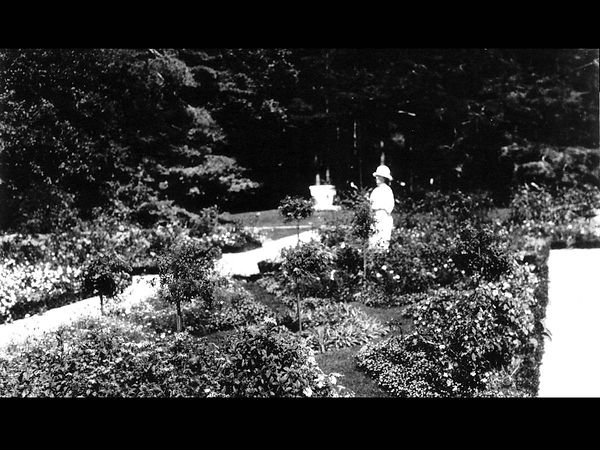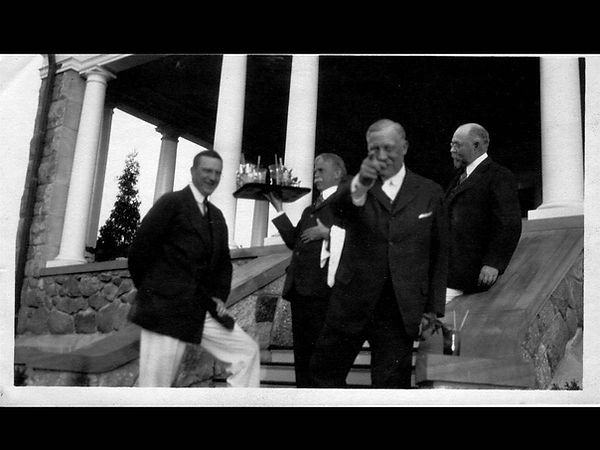Arboretum & Garden

Stop 3.1: History: John Dewolf
Bessie, an avid gardener, placed great emphasis on the landscape. She hired John DeWolf to lay out the grounds.
DeWolf organized his ideas into five major categories:
1. structures,
2. walks and drives,
3. lawn and grass areas,
4. plantings around the house, and
5. gardens.
During our tour today, you’ll notice these five features blending seamlessly into one another. Few walls or stiff dividing lines exist; instead, the original, natural beauty of this land shines through.
DeWolf, although a native of Bristol, was the Landscape Architect of the Borough of Brooklyn NY and completed Prospect Park. Afterwards, he was appointed landscape Architect of the entire city of Greater New York having sole charge of the entire park work for four years after consolidation of the different boroughs. He always had the direction of the landscape work at Blithewold and no changes or additions were made without his approval during the years he worked with Bessie on the estate.
DeWolf had a long family history in Bristol and with Blithewold dating from the 1700s. In the 1780s, Captain John DeWolf, who later became a US Senator, acquired extensive land holdings in the southern part of Bristol. The sum of this acquisition became known as “The Farm,” and included Blithewold, Roger Williams University, and several other large estates.
Upon the death of Senator John DeWolf in 1841, the property was left to his two grandsons. Dr. John James DeWolf (a dentist) received the part of the property west of Ferry Road, including the land that is now Blithewold. The property on Mount Hope Bay, including the estate buildings on the north side of Griswold Avenue, was left to Algernon Sidney DeWolf, father of landscape gardener John DeWolf.
DeWolf’s design at Blithewold reflects a widespread interest in America’s 17th and 18th-century heritage that manifested itself in both the Colonial Revival and the American Arts and Crafts movements.

Stop 3.2: History: Women and Landscape Design
Though not professionally trained, Bessie and her daughter Marjorie were hands-on gardeners who operated with a high level of sophistication to develop a property that gained widespread interest because of its horticultural excellence and planting schemes. While the initial design of the Blithewold landscape in the 1890s was primarily the work of John DeWolf, Bessie was actively involved in the selection of plant material from the 1890s on and assumed increasing responsibility for the grounds after DeWolf’s death.
Implementation of her design choices is what makes Blithewold such a rich and vibrant place today.
Based on what is known, it is clear that Blithewold is an important example of the trend toward greater involvement by women, both as amateurs and professionals, in landscape design at the turn of the century.
Mark Alan Hewitt, author of ‘The Architect and the Country House’, notes that:
“Among wealthy women, the real tastemakers, gardening supplanted elaborate costumes and decoration as a mark of feminine gentility and culture.”
Wendy Hitchmough notes in ‘Arts and Crafts Gardens’ that:
“wives and daughters of wealthy Victorian industrialists and entrepreneurs . . . had both time and resources at their disposal and, in an age when nursing and teaching were the only careers that respectable women were encouraged to follow (and then only under certain circumstances), garden design and garden making came to represent an essential release for physical and creative energy.”
This period also marked the very early days of academic programs for women in landscape design, paralleling developments in architecture. The earliest women practitioners worked under mentors-- Beatrix Farrand with Charles Sprague Sargent, and Ellen Biddle Shipman with architect Charles Platt. In 1901, Mrs. Edward Gilchrist Low started the Lowthorpe School in Groton, Massachusetts, and in 1910, Jane Haines began the Pennsylvania School of Horticulture for Women in Ambler, Pennsylvania.

Stop 3.3: History: North Garden
The North Garden, also known as the Sunken Garden, was a collaboration between Bessie and John DeWolf, begun in 1911, to provide a more formal flower garden, as well as a place for lawn bowling. It is partially enclosed on the south by a stone wall, with steps leading down into the garden and low retaining walls on east and west sides. It is an unusual juxtaposition of formal planting beds with box border, open lawn areas, and proximity to woodland. When constructed it was more formal than it is today but far less formal than many estate gardens of the period.
The garden was completed in 1912 but maintaining it was time-consuming and demanding. The severe winters of 1918 and 1933 killed the boxwood hedges which bordered the stone walls. Today, only the exterior beds remain. Even so, the North Garden remained a serene and beautiful experience for the family and visitors alike, blooming from May through October, as it does today.

Stop 3.4: Construction With Marjorie, Bessie, and Augustine
The beds in the North Garden are much more informal than they were originally. However the garden's straight lines and sharply edged gravel paths lend an air of formality not seen in other gardens on the property. Today, it blooms richly from spring through fall. As you enter, turn left and walk along the flower beds. Stop when you reach the stone wall.
Bessie’s outdoor- and nature-loving family took an active role in this garden’s construction. Even Augustine, her youngest daughter, hacked at the stones that became part of the wall you’re standing in front of with a pick-axe when she was only 12.
Notice the inlaid shell fountain. It was moved here from the Bosquet in 1911.

Stop 3.5: Spring
If you’re visiting early in the spring, you can look beyond the beds and into the trees beyond - the daffodils should be blooming everywhere you look. Blithewold has over 100,000 daffodils each year. I’ll elaborate on the varieties when we enter the Bosquet, or wooded area, beyond.

Stop 3.6: Summer
More information coming soon.

Stop 3.7: Fall
More information coming soon.

Stop 3.8: Winter
More information coming soon.

Stop 3.9: Playing Lawn Bowls
To view this historical photograph, click on the expand button on the bottom left of the picture.

Stop 3.10: Construction
To view this historical photograph, click on the expand button on the bottom left of the picture.

Stop 3.11: View From South Side
To view this historical photograph, click on the expand button on the bottom left of the picture.

Stop 3.12: Men Working
To view this historical photograph, click on the expand button on the bottom left of the picture.

Stop 3.13: Bessie, 1923
To view this historical photograph, click on the expand button on the bottom left of the picture.

Stop 3.14: Estelle Working
To view this historical photograph, click on the expand button on the bottom left of the picture.

Stop 3.15: North Garden With People
To view this historical photograph, click on the expand button on the bottom left of the picture.

Stop 3.16: North Porch Party, 1914
To view this historical photograph, click on the expand button on the bottom left of the picture.